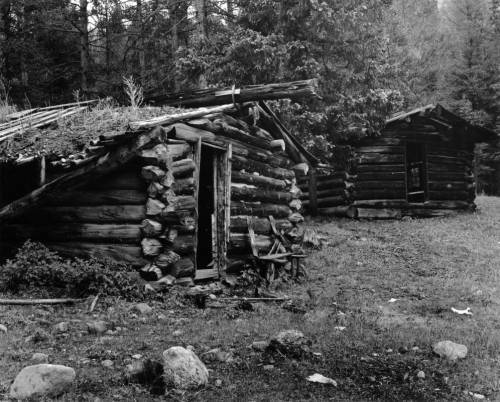GRAND COUNTY, Colo. — Decades before Rocky Mountain National Park was designated, it was home to a mining community that ran off almost as quickly as it moved in, leaving behind ruins you can still see today.
The ghost town is called Lulu City.
Visitors can enter from the west side of the park — at Grand Lake — and from the Colorado River Trailhead, follow the wide and flat trail along the river to Lulu City's remains. The hike is about 3.7 miles one way, according to the Town of Grand Lake. A short and steep one-mile hike beyond the ghost town will take a hiker to Little Yellowstone Canyon, which features sweeping views of the Colorado River valley.
The creation of Lulu City came at the very start of Colorado's silver boom — far from the park's 109th birthday Friday.

In 1879, prospectors and entrepreneurs William B. Baker and Benjamin Franklin Burnett from Fort Collins organized a group and marched into the Kawuneeche Valley on the west side of the modern-day national park, according to the National Park Service (NPS). They were tipped off in June of that year, when prospectors made two claims of silver on Mount Shipler along Lost Creek, and headed out to try to make claims of their own.

Digital Originals
RMNP, Rocky Mountain Conservancy working to preserve historic structures
By that summer, a small historic mining town started to take shape. They named it Lulu City, reportedly after Burnett's daughter.
Like many of Colorado's mining towns during this period, Lulu City saw a rapid rise in activity, followed by a collapse that was nearly as swift.

In the early days, a plan outlined a vision of 100 blocks and 16 lots, all divided by 19 streets and four avenues, according to the NPS. New cabins stood up quickly and people scoured the hillsides for precious ores.
At its peak, Lulu City was home to 1,500 people, as reported in 1989 by The Estes Park Trail. A walk around town could lead a visitor to a butcher shop, real estate agency, mining exchange, a hotel, general stores, a barber shop, hardware store, liquor store, a dairy and roughly 40 houses, the NPS reported.
Regardless of its charming name and the picturesque landscape, Lulu City was not always a peaceful place. As reported by The Estes Park Trail on May 22, 1981, many residents held prejudices against others and violence was not uncommon. In one instance that the paper reported on, a group of Dutch men attacked multiple peaceful people, but were then "soundly beaten, and their homes were wrecked by angry townspeople." The Dutch men were run out of town.
Lulu City's small boom was short-lived — the high cost of transportation paired with low-grade ores chased people away, though outsiders wouldn't know based on the ongoing news reports promising "immense richness" and a booming future, according to the NPS.
The fall of the small community started as winter settled in. Many miners deserted the town, and roads and trails became impassable. In the winter of 1881-1882, only 10 mines were active in Lulu City, according to NPS. On top of that, mine owners struggled to turn a profit on low-yielding ore if they had to transport tons of it dozens of miles to a mill.

When the weather warmed into the summer of 1882, more prosperous times returned, though morale was lower, as people knew they'd gain little profit without a smelter in town, the NPS said.
After a tough winter, another blow came in April 1883, when one of the large mines of the area shut down and all of its miners were laid off, according to the NPS. While smaller mines continued to chug ahead, by the time the winter arrived again, all of the mines in Lulu City were abandoned.
The final kick came in 1884, when the federal government announced it would close Lulu City's post office, as reported by The Estes Park Trail on May 28, 1975.
It was a ghost town by 1885.
As written in a report in the July 6, 1952 Rocky Mountain News, "One legend of Lulu City claims that the people deserted it so fast clothes were left hanging in the closet and dishes standing on the table."

While some residents had moved to a nearby mining town called Dutchtown — where the Dutch men accused in the violent brawl had been sent to — that too collapsed and was abandoned.
William Allen White, editor of the Emporia Gazette in Kansas and a political figure at the time, described a visit to Moraine Park and Lulu City in an autobiography, which was published posthumously in 1946. His description tells of a haunting picture.
It reads: "There was the post office, with the letters in the boxes; the saloons with the empty bottles on the shelves; the billiard tables with their green baize, moth-eaten and rat-gnawed; the stores with their shelves like grinning skulls empty of their fleshy furnishings; in the cabins the cookstoves stood in the kitchens and iron safes standing open, too heavy to be moved. It was a dramatic picture — the little town of Lulu down on the Grand (River, now known as the Colorado River)."

Local
Colorado ghost towns: Their past, present and future in the Rocky Mountains
The site became part of Rocky Mountain National Park in 1949.
Today, aside from a few old mine shafts and the ruins of nine cabins — only three of which are truly recognizable — there is little left to show that Lulu City was once home to any people.






